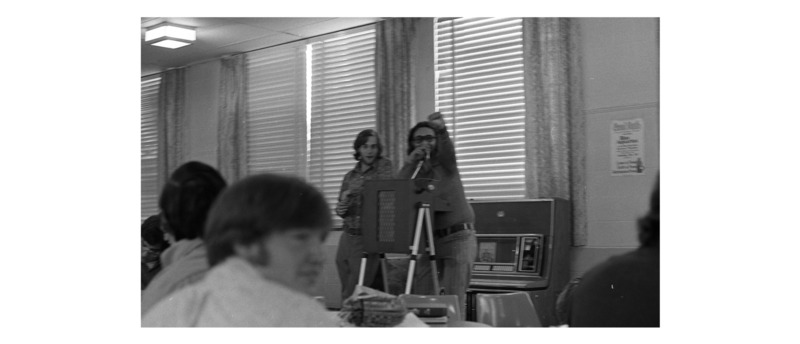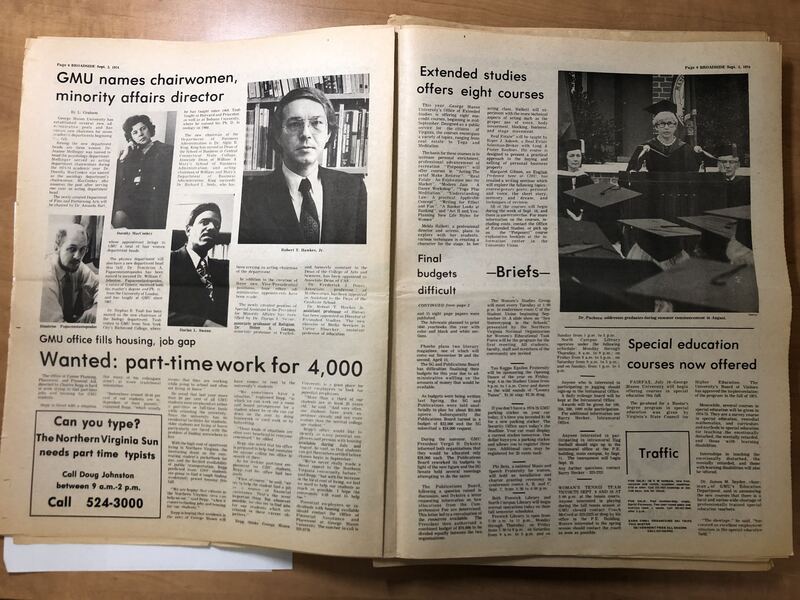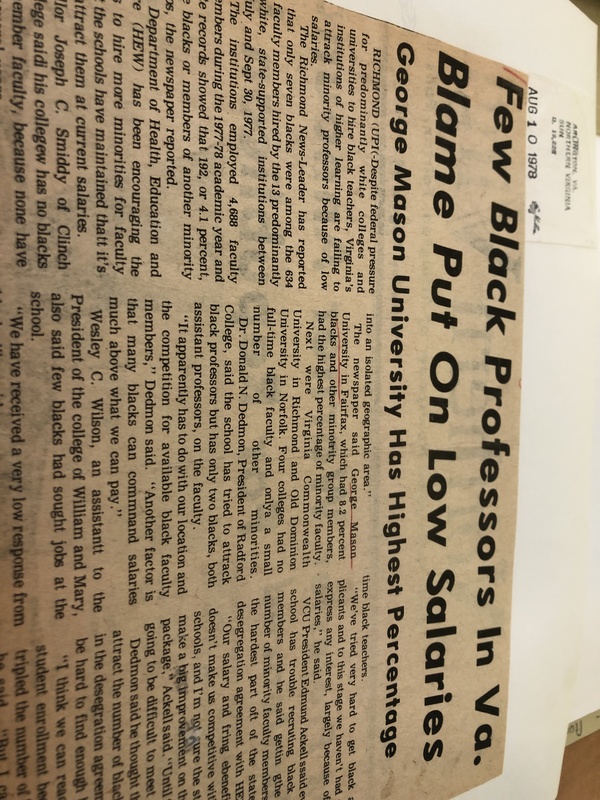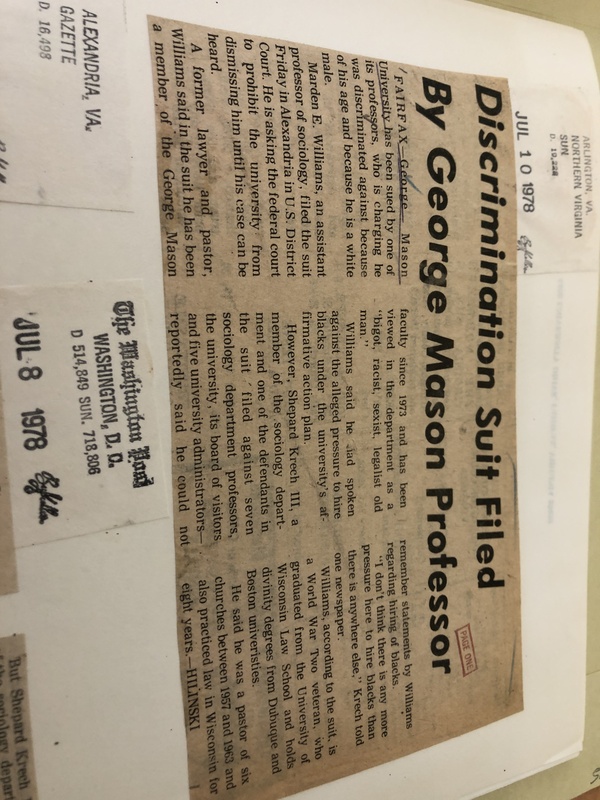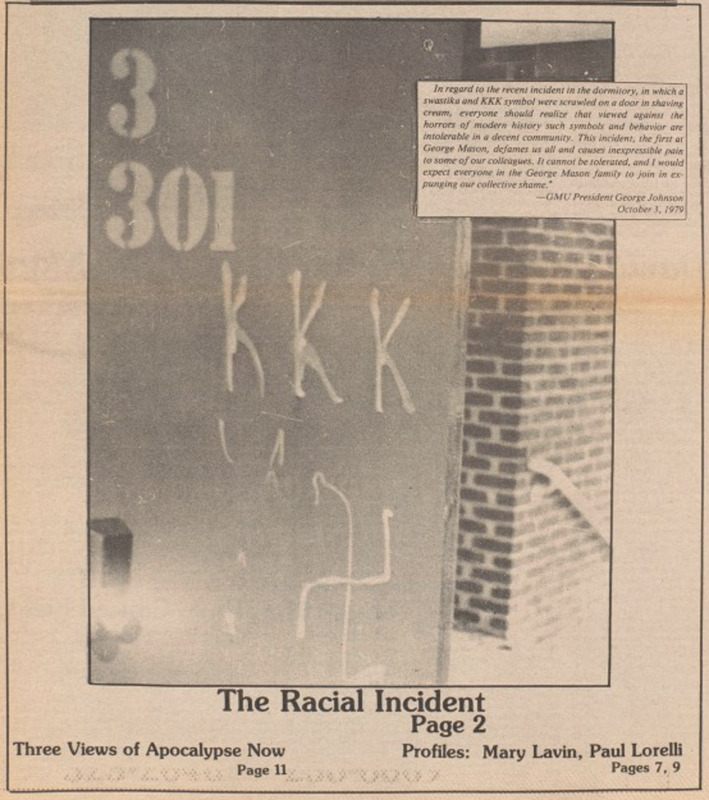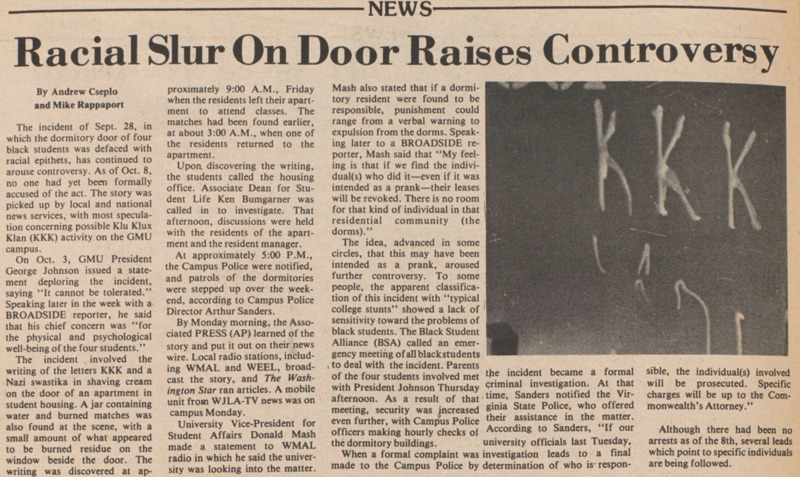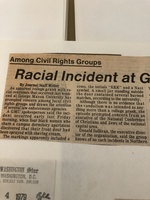1960s into 1970s: George Mason and Racial Ridicule - cont.
With these charges brought up against the university, their hand was forced. Changes start to appear in the university as the administration contended with the outside forces displaying plainly the racism and institutional failings in the university. However, this does not mean things were fixed overnight, or that underlying issues went away.
In 1973 ‘slave day’, or the slave sale fundraiser, was held for the first time since 1971. Pictures of the event demonstrate that it was led by white students, and attended by white students. Little information exists on this slave day besides photographs.[1] While this is the last known slave day on GMU, it represents the remaining culture of racial ridicule at the university if not an undercurrent.
Though the HEW report called out GMU for its institutional problems, direct changes did not occur in the administration quickly. The rest of the decade provides interesting examples of shifts at the university, where it appears that the university did at least attempt surface level change. Yet, it took until 1974 for an official minority student recruiter to be hired.
Andrew “Andy” Evans, a Black Alexandria-native was brought in to the university in February 1974. The former campaign manager was successful in getting the first Black person, Ira L. Robinson, to be elected to the Alexandria City Council in 1970. He was tasked with improving recruiting, outreach, and attracting more minority students to GMU.[2] Later that year, Darius Swann was hired as Special Assistant to the President for Minority Affairs.[3] Three years later, in April 1977, to reinforce its own policy on affirmative action and non-discrimination in employment, GMU appointed Carl Cannon as director of equal opportunity and affirmative action.[4]
These three administrative positions represent the university stepping up to follow federal laws, and expand access to minorities. Yet, as 1978 reporting shows, the university was still failing to hire Black teachers. Throughout the state, colleges were being charged with failing to attract and bring in Black teachers, with GMU having 8.2% of its faculty being Black or another minority group.[5]
These issues of minority recruitment, and attempts at raising the amount of people of color at the university brought with it further tension. A 1978 suit by the white GMU professor Marden E. Williams charged the university with reverse-discrimination. Williams charged that “he was discriminated against because of his age and because he is a white male... he has been a member of the George Mason faculty since 1973 and has been viewed in the department as a ‘bigot, racist, sexist, legalist old man.’ Williams said he had spoken against the alleged pressure to hire blacks under the university’s affirmative action plan.”[6] This was likely instigated by the Regents of The University of California v. Bakke Supreme Court case. Marden, like Bakke with the University of California and white students, was charging GMU with reverse-discrimination against white employees.
A final and concerning incident came at the end of the decade. On September 28, 1979, Klan symbols, a cross, and a Nazi symbol were scrawled in shaving foam on a GMU apartment door.[7] In front of the door sat a jar of water with burnt matches.[8] The four Black GMU students who lived in the multi-building campus complex found the markings and matches early Friday morning.[9] While the university took all initiatives to search for the perpetrators and turned the investigation over to law enforcement, this incident represents the lingering racial tensions and history of race-based issues on campus.
The 1970s were a challenging decade for George Mason University. The culture of the campus built over the previous two decades bred a campus life that was hostile to Black students. Yet, the 1970s appears to have brought with it some kind of recognition in the student body. Resistance by the majority white students in 1970s and into 1971 represent this. Calls for change from the outside by private citizens and the federal and state government further challenged the system of white supremacy in the school’s administration and the student body. This brought change too, the hiring of Andrew Evans as a minority student recruiter, Darius Swann as minority affairs director, and Carl Cannon as Director of Equal Opportunity and Affirmative action show this.
Change was not immediate though, and racial incidents throughout the decade show this. A slave day occurred in 1973, the rise of the Bakke case and Marden Williams’ suit against the university, followed by Klan and Nazi symbols being drawn on 4 Black student’s apartment door all demonstrate a culture that was hard to shake at GMU. This also calls into question whether there was further resistance by Black students, Black faculty, and Black student groups during this decade. As the percentage of Black students on campus rose during the decade, it may have happened. The archive at GMU fails to make note of this though, leaving a blank space in the research requiring further study.
As the decade ended, the Klan and Nazi symbols drawn on the door represent something of a harbinger of the next decade and a half on campus. What comports to a revivalist culture of open and outward demonstrations of racism returns to campus. The 1980s and the early 1990s are ushered in by the late September 1979 incident and show that racial ridicule at GMU was not something that had gone away.
[1] Michele J. Rubenstein, “Photograph: Slave Sale 5” (George Mason University. Libraries. Special Collections & Archives., n.d.), Box 7, page 37, Frame 4, R0135: George Mason University Broadside photograph collection, http://images.gmu.edu/luna/servlet/detail/GMUDPSdps~38~38~87698~103700:Slave-sale-5..
[2] “‘Involvement’ in Recruiting,” Northern Virginia Sun, February 26, 1974.
[3] L Graham, “GMU Names Chairwoman, Director of Minority Affairs,” Broadside, September 3, 1974.
[4] “George Mason Names Employment Watchdog,” Fairfax Globe, April 14, 1977.
[5] “Few Black Professors in Va. Blame Put on Low Salaries,” Northern Virginia Sun, August 10, 1978.
[6] “Discrimination Suit Filed By George Mason Professor,” Northern Virginia Sun, July 10, 1978.
[7] “Klan Symbols Scrawled On Door of 4 Black George Mason Coeds,” Washington Star, October 3, 1979.
[8] Andrew Cseplo, “Racial Slur On Door Raises Controversy,” Broadside, October 10, 1979.
[9] Journal Staff Writer, “Racial Incident at GMU Stirs Concern,” Manassas Journal Messenger, October 5, 1979.

